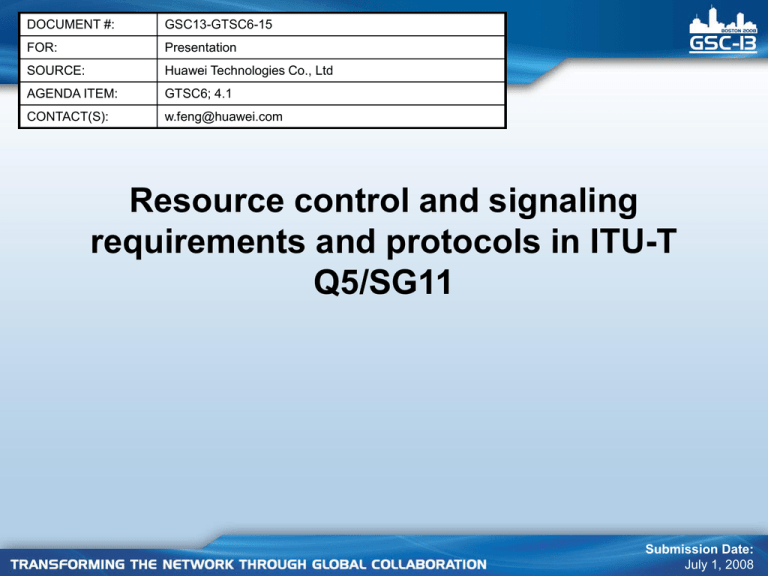DOCUMENT #: GSC13-GTSC6-15 FOR: Presentation
advertisement

DOCUMENT #: GSC13-GTSC6-15 FOR: Presentation SOURCE: Huawei Technologies Co., Ltd AGENDA ITEM: GTSC6; 4.1 CONTACT(S): w.feng@huawei.com Resource control and signaling requirements and protocols in ITU-T Q5/SG11 Submission Date: July 1, 2008 Highlight of Current Activities (1) • Developing standards to define the resource control and signaling requirements and protocols in NGN • Recently completed work: – Architectural framework for the Q.33xx series of Recommendations – Protocol at the interface between Service Control Physical Entity (SC-PE) and Resource and Admission Control Physical Entity (RAC-PE) (Rs interface) version 1 – Protocol at the interface between Transport Resource Control Physical Entities (TRC-PEs) (Rp interface) version 1 – Protocols at the Rw interface between a Policy Decision Physical Entity (PDPE) and a Policy Enforcement Physical Entity (PE-PE): Overview – Protocol at the interface between Policy Decision Physical Entity (PD-PE) and Policy Enforcement Physical Entity (PE-PE) (Rw interface) version 1: COPS Alternative, H.248 Alternative and Diameter 2 Highlight of Current Activities (2) – Protocol at the interface between a Transport Resource Control Physical Entity (TRC-PE) and a Transport Physical Entity (T-PE) (Rc interface): COPS alternative and SNMP Profile – Protocol at the interface between Policy Decision Physical Entity (PD-PE) and Transport Resource Control Physical Entity (TRC-PE) (Rt interface) in access network – Signalling flows for resource control • Currently building specifications for QoS Coordination Protocol • Q.PCNApp newly created to describe enhancement of RACF to use precongestion notification (PCN) • Recently create resource control protocol for Flow State Aware Access QoS Control in NGN • Working closely with global liaison partners. • Published 11 standards in ITU-T 4 years period (see slide 12,13) -- 15 currently in draft format. 3 Strategic Direction (1) • The ITU-T Q5/SG11 standards have been defined to fulfill the following tasks (but not limited to): – controlling gates at networks boundaries in NGNs; – supporting interactions of applications and session control functions with resource control functions in NGNs; – controlling media gateways in NGNs; – controlling specialized resources in NGNs; – interaction among resource control domains; and – Joint development of specifications of interfaces to adjacent layers with relevant Questions groups. • Whenever possible, ITU-T Q5/SG11 standards are align with the work of other SDOs, including the ETSI, 3GPP, IETF and DSL Forum – Continue with ETSI and 3GPP coordination and collaboration – Established important relationships with all of the leading organizations working in the resource control and signaling requirements/protocols realm to share our end-to-end view of the standards being developed. 4 Strategic Direction (2) • Q5/SG11 is developing standards for signaling and control interactions between service and transport layers to enable, e.g., session servers and application servers to control transport resources and associated QoS, in real time – Northbound Interface Signaling Requirements (Rs) – Horizontal Interface Signaling Requirements (Rt, Rp, Ri, Rd,Rh) – Southbound Interface Signaling Requirements (Rw, Rc) • Q5/SG11 is developing QoS Coordination Protocol, enhancement of RACF to use pre-congestion notification (PCN) and resource control protocol for Flow State Aware Access QoS Control in NGN • Timely completion of deliverables to support deployment of standardized resource admission and control architecture 5 Challenges • Resource control and traffic management in support of IPTV service • Signaling requirements and protocols supporting mobility control • Signaling requirements and protocols between DSLAM and BRAS 6 Next Steps/Actions • Architectural framework for the Q.33xx series of Recommendations version 2 • Rs, Rp, Rw, Rc, Rt version 2 and continue Ri, Rd, Rh • Continue QoS Coordination Protocol, enhancement of RACF to use pre-congestion notification (PCN) and resource control protocol for Flow State Aware Access QoS Control in NGN • Coordination between RACF and GMPLS/PCE-controlled transport network • Continue to work cooperatively with external organizations on aligning efforts and work products. 7 Proposed Resolution [optional] • N/A 8 Supplemental Slides 9 ITU-T Resource Admission and Control Functional architecture Service Control Functions Service Stratum Transport Stratum Rh CPE/CPN Rs RACF Ru Rd Rp Rt PD-FE TRC-FE Rn Rc TRE-FE Ri Other NGNs Network Attachment Control Functions Rw PE-FE Transport Functions 10 Implementations of functional entities • Mapping from functional to physical entities concerned with resource admission and control Functional Entity Abbrev. Physical Entity Abbrev. Service Control Functions SCF Service Control Entity (e.g. implementation of P-CSCF) SCE Network Attachment Control Functions NACF Network Attachment Control Entity NACE Policy Decision Functional Entity PD-FE Policy Decision Physical Entity PD-PE Transport Resource Control Functional Entity TRC-FE Transport Resource Control Physical Entity TRC-PE Transport Resource Enforcement Functional Entity TRE-FE Transport Resource Enforcement Physical Entity TRE-PE Transport Functions in general TF Transport Physical Entity (of various types, possibly limited by context) T-PE Policy Enforcement Functional Entity PE-FE Policy Enforcement Physical Entity PE-PE CPN Gateway Policy Decision Functional Entity CGPD-FE CPN Gateway Policy Decision Physical Entity CGPD-PE 11 ITU-T Q5/SG11 Published Standards (1) Standard Number Title Q.Sup51 Signalling requirements for IP QoS Q.3300 Architectural framework for the Q.33xx series of Recommendations Q.3301.1 Protocol at the interface between Service Control Physical Entity (SC-PE) and Resource and Admission Control Physical Entity (RAC-PE)) (Rs interface) version 1 Q.3302.1 Protocol at the interface between Transport Resource Control Physical Entities (TRC-PEs)) (Rp interface) version 1 Q.3303.0 Resource control protocol No. 3 Protocols at the Rw interface between a Policy Decision Physical Entity (PD-PE) and a Policy Enforcement Physical Entity (PE-PE): Overview Q.3303.1 Protocol at the interface between Policy Decision Physical Entity (PD-PE) and Policy Enforcement Physical Entity (PE-PE) (Rw interface) COPS Alternative version 1 Q.3303.2 Protocol at the interface between Policy Decision Physical Entity (PD-PE) and Policy Enforcement Physical Entity (PE-PE) (Rw interface) H.248 Alternative version 1 12 ITU-T Q5/SG11 Published Standards (2) Standard Number Title Q.3303.3 Protocol at the interface between the Policy Decision Physical Entity (PD-PE) and the Policy Enforcement Physical Entity (PE-PE) (Rw interface): Diameter Q.3304.1 Protocol at the interface between a Transport Resource Control Physical Entity (TRC-PE) and a Transport Physical Entity (T-PE) (Rc interface): COPS alternative Q.3304.2 SNMP Profile Protocol at the Rc interface between a Transport Resource Control Physical Entity (TRC-PE) and a Transport Physical Entity (T-PE) (Rc interface) Q.3305.1 Protocol at the interface between Policy Decision Physical Entity (PDPE) and Transport Resource Control Physical Entity (TRC-PE) (Rt interface) in access network TRQ.rsf Signalling flows for resource control 13 ITU-T Q5/SG11 current drafts (1) Standard Number Title Q.3320 Architectural framework for the Q.33xx series of Recommendations, version 2 Q.3321.1 Protocol at the interface between Service Control Physical Entity (SC-PE) and Resource and Admission Control Physical Entity (RAC-PE)) (Rs interface) version 2 Q.3322.1 Protocol at the interface between Transport Resource Control Physical Entities (TRC-PEs)) (Rp interface) version 2 Q.3323.1 Protocol at the interface between Policy Decision Physical Entity (PD-PE) and Policy Enforcement Physical Entity (PE-PE) (Rw interface) COPS Alternative version 2 Q.3323.2 Protocol at the interface between Policy Decision Physical Entity (PD-PE) and Policy Enforcement Physical Entity (PE-PE)) (Rw interface) H.248 Alternative version 2 Q.3323.3 Protocol at the interface between the Policy Decision Physical Entity (PD-PE) and the Policy Enforcement Physical Entity (PE-PE) (Rw interface): Diameter version 2 Q.3324.1 Protocol at the interface between a Transport Resource Control Physical Entity (TRC-PE) and a Transport Physical Entity (T-PE) (Rc interface): COPS alternative version 2 14 ITU-T Q5/SG11 current drafts (2) Standard Number Q.3324.2 Q.3325.1 Q.3306 Q.3307 Q.3308 Title SNMP Profile Protocol at the Rc interface between a Transport Resource Control Physical Entity (TRC-PE) and a Transport Physical Entity (T-PE) (Rc interface) version 2 Protocol at the interface between Policy Decision Physical Entity (PD-PE) and Transport Resource Control Physical Entity (TRC-PE) (Rt interface) in access network version 2 Protocol at the interface between intra-domain Policy Decision Physical Entities (PD-PEs) (Rd interface) Protocol at the interface between inter-domain Policy Decision Physical Entities (PD-PEs) (Ri interface) Protocol at the interface between Resource Admission Control Physical Entity (RAC-PEs) and Customer Premise Physical Entity (CP-PEs) (Rh interface) Q.QCP QoS Coordination Protocol Q.PCNApp Enhancement of resource admission and control protocols to use pre-congestion notification (PCN) Q.FlowStateSig Resource control protocol for Flow State Aware Access QoS Control in an NGN 15 ITU-T Q5/SG11 Liaisons and Collaboration Include… • European Telecommunications Standards Institute (ETSI) and TISPAN WG2, WG3 and WG5 • 3GPP CT3, SA2 • DSL Forum • IETF PCN WG, MEXT 16





